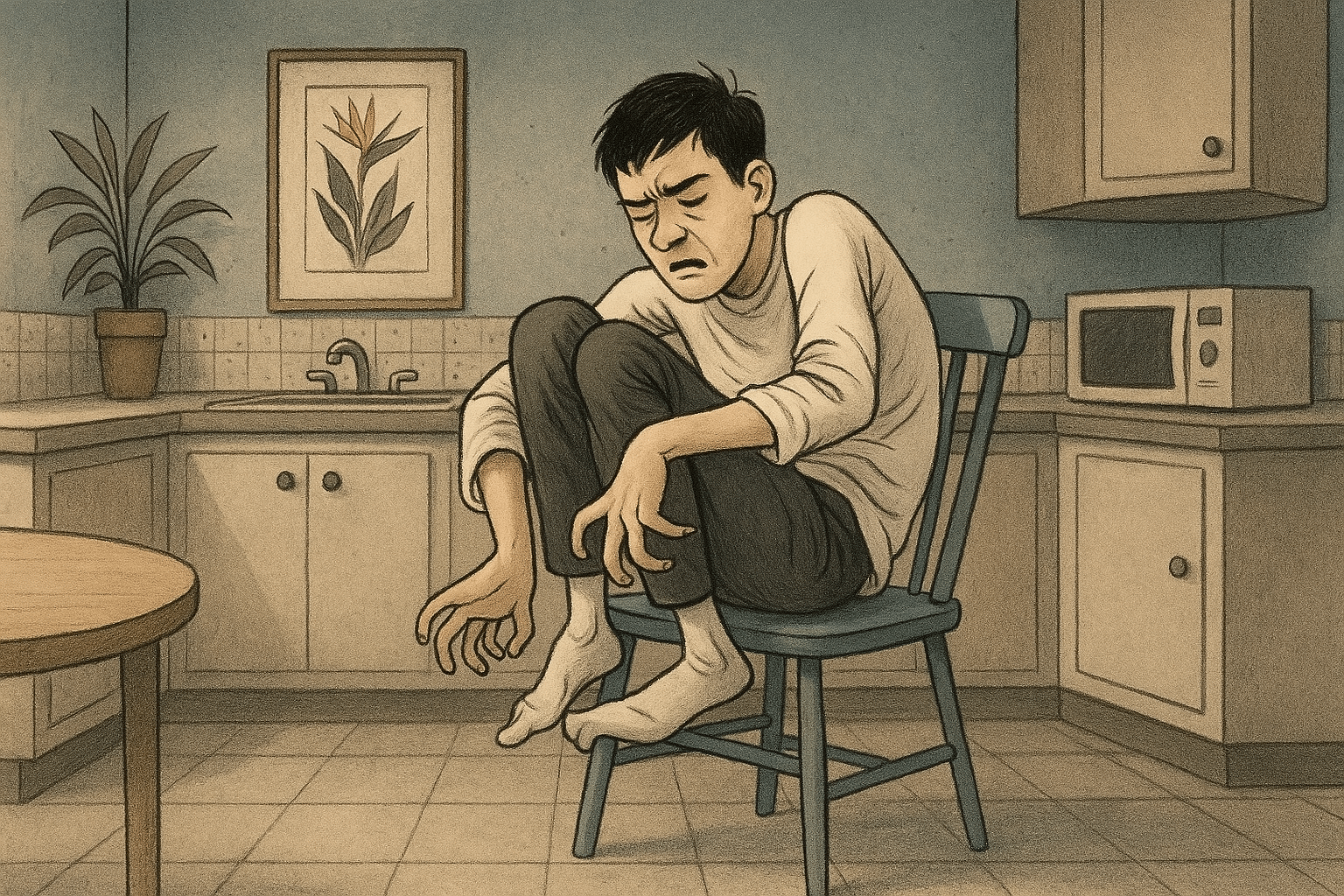Key Takeaways
- Catatonic schizophrenia combines schizophrenia symptoms with catatonia, which includes motor disturbances, speech abnormalities, and behavioral symptoms like negativism and repetitive movements.
- Catatonic schizophrenia involves a complex interplay of genetic predisposition, neurobiological factors, and potentially environmental triggers.
- Effective management typically requires a multi-faceted approach combining medication, psychotherapy (particularly CBT), and, in some cases, electroconvulsive therapy (ECT).
- Successful long-term outcomes depend on consistent follow-up care, medication adherence, healthy lifestyle choices, and strong social support systems to prevent relapse and promote recovery.
- A Mission For Michael (AMFM) provides specialized treatment for catatonic schizophrenia through accredited facilities across Southern California, Minnesota, and Virginia.
What is Catatonic Schizophrenia?
Understanding catatonic schizophrenia begins with recognizing it as a unique form of schizophrenia where catatonia plays a significant role. While the term “catatonic schizophrenia” is somewhat outdated, the condition remains relevant as it involves distinct symptoms that require specialized attention.
Catatonia itself is a state that can dramatically affect how a person moves or doesn’t move at all. This condition can range from complete immobility to excessive motor activity that seems purposeless.
Founded in 2010, A Mission For Michael (AMFM) offers specialized mental health care across California, Minnesota, and Virginia. Our accredited facilities provide residential and outpatient programs, utilizing evidence-based therapies such as CBT, DBT, and EMDR.
Our dedicated team of licensed professionals ensures every client receives the best care possible, supported by accreditation from The Joint Commission. We are committed to safety and personalized treatment plans.
Definition and Key Features
Catatonic schizophrenia is characterized by a range of symptoms that primarily impact movement and behavior. These symptoms can include everything from lack of movement, known as stupor, to excessive movement, referred to as excitement. Besides that, individuals may also exhibit unusual postures, resistance to movement, or mimicry of speech and actions.
Note that catatonia can occur in various mental health conditions, but when it appears as part of schizophrenia, it adds a layer of complexity to the diagnosis and treatment.
Differences From Other Types of Schizophrenia
While all types of schizophrenia share some core symptoms like delusions and hallucinations, catatonic schizophrenia stands out due to the prominence of motor symptoms. In contrast, other forms, such as paranoid schizophrenia, are primarily characterized by intense delusions and auditory hallucinations.
Recognizing Symptoms
Motor Disturbances
Changes to movement can come in the form of a complete lack of movement (sometimes called stupor), where the individual may appear to be in a trance-like state, or as excessive motor activity that may seem purposeless (known as catatonic excitement).
Another key symptom is waxy flexibility, where a person’s limbs remain in the position they are placed by someone else. This symptom can be particularly distressing for both the individual and their loved ones.

Sometimes when catatonic schizophrenia affects a person’s posture and flexibility, normal movements become challenging.
Speech Abnormalities
Speech abnormalities in catatonic schizophrenia can include mutism, where the individual does not speak at all, or echolalia, where they repeat words or phrases spoken by others. These symptoms can make communication challenging and may lead to social isolation.
It’s vital to approach these speech disturbances with patience and understanding, as they are not a reflection of the person’s willingness to communicate but rather a symptom of the condition.
Behavioral Symptoms
Behavioral symptoms can vary widely and include negativism, where the individual resists instructions or attempts to be moved, and stereotypy, which involves repetitive movements or actions. These behaviors can be disruptive and may require specialized interventions to manage effectively.
Underlying Causes
Genetic Influences
If you have a family history of schizophrenia or other mental health disorders, your risk of developing catatonic schizophrenia may be higher. Researchers have identified several genetic factors that may contribute to this increased risk, although the exact mechanisms are still being studied.
Understanding the genetic component is vital because it can inform both prevention strategies and treatment options. For instance, knowing your family history can prompt earlier screening and intervention, which can significantly improve outcomes.
Neurobiological Factors
These involve abnormalities in brain structure and function, which can influence how symptoms manifest. For instance, imbalances in neurotransmitters like dopamine and glutamate are often implicated in schizophrenia, affecting mood, thought processes, and movement.
Brain imaging studies have shown that individuals with schizophrenia may have differences in brain volume and connectivity. These differences can impact how the brain processes information, leading to the symptoms associated with catatonic schizophrenia.
How Can it be Diagnosed?
Clinical Evaluation
The clinical evaluation involves a thorough assessment by a mental health professional, who will observe the individual’s symptoms and behavior. This assessment often includes interviews with the patient and their family to gather detailed information about the symptoms and their impact on daily life.
During the evaluation, the clinician will look for specific signs of catatonia, such as motor disturbances, speech abnormalities, and behavioral symptoms. These observations are necessary for differentiating catatonic schizophrenia from other mental health conditions with similar symptoms.
Diagnostic Criteria
To diagnose catatonic schizophrenia, the individual must meet specific diagnostic criteria outlined in mental health manuals such as the Diagnostic and Statistical Manual of Mental Disorders, Fifth Edition (DSM-5). These criteria include the presence of catatonia as a prominent feature alongside other schizophrenia symptoms like delusions or hallucinations.
Additionally, clinicians consider the duration and impact of symptoms on daily functioning. Meeting these criteria ensures that the diagnosis is accurate and that the individual receives appropriate treatment unique to their needs.
Effective Treatment Options
Medication Options
Antipsychotics can help manage symptoms like delusions and hallucinations, while benzodiazepines are commonly used to treat catatonia itself.
In some cases, mood stabilizers or antidepressants may also be prescribed to address co-occurring symptoms. Work closely with a healthcare provider to find the right medication and dosage, as this can significantly impact the effectiveness of the treatment.
Psychotherapy Techniques
Psychotherapy can be an effective component of treatment for catatonic schizophrenia. Cognitive-behavioral therapy (CBT) is often used to help individuals understand and manage their symptoms, develop coping strategies, and improve their overall quality of life.
Besides CBT, other therapeutic approaches such as family therapy or group therapy can provide additional support and help individuals build a strong support network. These therapies can empower individuals to take an active role in their treatment and recovery.

Group Therapy creates an environment where individuals can freely express themselves and feel supported because they can see and feel that they are not alone.
Electroconvulsive Therapy (ECT)
In cases where medications and psychotherapy are not effective, electroconvulsive therapy (ECT) may be considered. ECT involves delivering controlled electrical currents to the brain under anesthesia, which can help alleviate severe symptoms of catatonia.
While ECT can be highly effective for some individuals, it is usually considered a last resort due to its invasive nature. However, for those who do not respond to other treatments, ECT can provide significant relief and improve overall functioning.
Managing Catatonic Schizophrenia
Long-term Strategy
A long-term strategy for managing catatonic schizophrenia involves regular follow-up with healthcare providers, adherence to treatment plans, and monitoring for any changes in symptoms. This proactive approach can help prevent relapses and ensure that any new symptoms are addressed promptly.
Besides medical treatment, incorporating healthy lifestyle choices such as regular exercise, a balanced diet, and stress-reduction techniques can support overall well-being. Engaging in meaningful activities and maintaining social connections can also play a crucial role in recovery.

Healthy food contributes to a healthy mind. Ensuring that you eat good food for your body will have a positive impact on your well-being.
Family and Community Support
Having a strong support system can make a significant difference in the recovery process. Families can provide emotional support, help with treatment adherence, and assist in recognizing early signs of relapse.
Community support, including peer groups and mental health organizations, provides a space for individuals to share experiences and learn from others facing similar challenges. These networks can foster a sense of belonging and reduce feelings of isolation, which are common in those living with schizophrenia.
AMFM’s Approach to Catatonic Schizophrenia
Catatonic schizophrenia presents unique challenges through its distinct motor disturbances, speech abnormalities, and behavioral symptoms. At A Mission For Michael (AMFM), we understand that facing this condition can feel overwhelming for both individuals and their families.
Our approach combines evidence-based treatments—including carefully managed medication plans, specialized psychotherapy techniques like CBT and DBT, and, when appropriate, advanced interventions like ECT—all delivered by our licensed mental health professionals.
What sets AMFM apart is our comprehensive care model across our accredited facilities in Southern California, Washington, and Virginia. We recognize that effective treatment extends beyond symptom management to provide holistic recovery.
Our team creates personalized treatment plans that address not just the condition, but the whole person—supporting sustainable improvement in quality of life and daily functioning.

The AMFM Residential Facility has a lounge area where you can sit with a book or with company.
Frequently Asked Questions (FAQ)
What triggers catatonic schizophrenia?
Catatonic schizophrenia can be triggered by a combination of genetic, environmental, and neurobiological factors. Stressful life events, substance abuse, and other mental health conditions can also play a role in triggering symptoms.
Can catatonic schizophrenia be cured?
While there is no cure for catatonic schizophrenia, it can be effectively managed with the right treatment and support. Medications, therapy, and lifestyle changes can help control symptoms and improve quality of life.
How common is catatonia in schizophrenia?
Catatonia is a relatively rare symptom in schizophrenia, affecting a small percentage of individuals with the disorder. However, when it does occur, it can significantly impact daily functioning and quality of life.
What treatments are most effective?
Effective treatments for catatonic schizophrenia include a combination of medication, psychotherapy, and sometimes electroconvulsive therapy (ECT). Antipsychotics and benzodiazepines are commonly used to manage symptoms.
How can AMFM help with treatment?
At A Mission For Michael (AMFM), we are dedicated to providing comprehensive support for individuals with catatonic schizophrenia. We combine a range of treatments that are suited for each patient, all delivered by licensed medical professionals.












